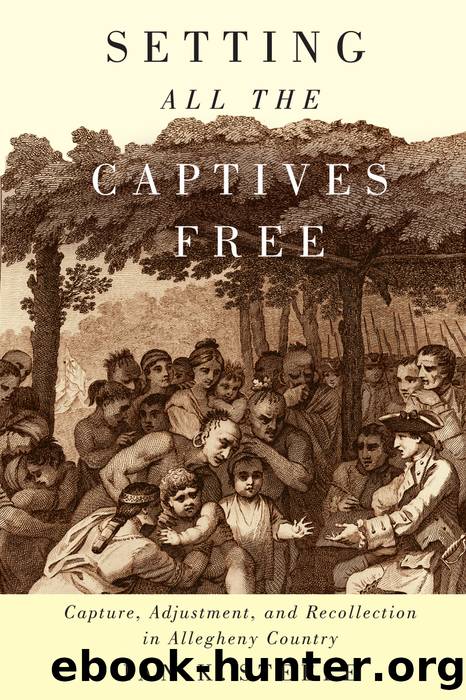Setting All the Captives Free by Steele Ian K.;

Author:Steele, Ian K.;
Language: eng
Format: epub
ISBN: 3332645
Publisher: McGill-Queen's University Press
18
Captivating Accounts, 1755â1826
As thickets of subsequent literary and historical analysis can testify, a captivity narrative was seldom just a captivity narrative. These stories were much too popular to have merely satisfied the curiosity of those who wanted to know what happened to captives. Captivity accounts have long been published and studied as American adventures in suffering and redemption, captivity and freedom, exile and return. Although they may have needed no further justification, the emotional attractiveness of captivity themes has also made them irresistible, then and since, to those with various conscious or unconscious agendas.1 This âescapeâ literature could be very potent and adaptable propaganda, appropriated to serve in the creation and preservation, or the questioning, of religious, cultural, and political solidarities. Such narratives were a familiar aspect of the early modern empires of Spain, France, and Britain.2 Accounts from British America, India, and the Mediterranean formed part of the cultural binding of an ambitious English-speaking empire in the eighteenth century, and British migrants and imperial soldiers were featured in the captivities and recoveries that were part of integrating Allegheny country into that empire.3 That imperial perspective lost out to a contending vision of an imagined American community that emerged within the lifetime of most early Allegheny captives, and their accounts could become iconic representations of a fight for freedom and a unique new American identity. Eighty-five-year-old Hugh Gibson gave the last returned captiveâs interview in 1826, and it serves as a sensible time to end this study of Allegheny captivity accounts. The remembered sufferings of captives would live on to serve as âjustification by sufferingâ for the relentless nineteenth-century confiscation and destruction of Indian country, and then became the foundational genre for studies of American literature.
Little attention has been paid to early Allegheny captivity narratives in their more immediate context, the remaking of Pennsylvania. The lifetime of a youth captured in the Allegheny borderlands in the 1750s was one of astounding changes. The period from 1754 to 1765 brought a global war to comparatively peaceful Allegheny borderlands, together with a political convulsion that overturned Quaker dominance, helped provoke the provinceâs first Indian war, and left unpunished the vigilante murderers of Indians. Over the next two decades, imperial solidarity evaporated, and the American War for Independence was fought against the regionâs Indians and their British allies. The victorious but fragile new republic promptly resumed a ferocious battle with the Shawnee and their allies for control of the Old Northwest.4 Memoirs of a couple of the longest-lived Allegheny captives of the 1750s were not published until after all of these intervening wonders had passed. Captivity accounts could also challenge all of the tidy-minded categories, as well as Christian, white, and male assumptions, because they were essentially cross-cultural experiences. Admiration for the simple sharing of an Indian family and its adopted kin, for the generous communal values of an Indian village, or for the natural freedom of a hunterâs life could be a telling critique of colonial life as well as a statement of longing for the same.
Download
This site does not store any files on its server. We only index and link to content provided by other sites. Please contact the content providers to delete copyright contents if any and email us, we'll remove relevant links or contents immediately.
Cecilia; Or, Memoirs of an Heiress — Volume 1 by Fanny Burney(32434)
Cecilia; Or, Memoirs of an Heiress — Volume 2 by Fanny Burney(31871)
Cecilia; Or, Memoirs of an Heiress — Volume 3 by Fanny Burney(31854)
The Great Music City by Andrea Baker(31349)
We're Going to Need More Wine by Gabrielle Union(18967)
All the Missing Girls by Megan Miranda(15572)
Pimp by Iceberg Slim(14394)
Bombshells: Glamour Girls of a Lifetime by Sullivan Steve(13973)
Talking to Strangers by Malcolm Gladwell(13222)
Norse Mythology by Gaiman Neil(13207)
Fifty Shades Freed by E L James(13157)
For the Love of Europe by Rick Steves(12998)
Mindhunter: Inside the FBI's Elite Serial Crime Unit by John E. Douglas & Mark Olshaker(9201)
Crazy Rich Asians by Kevin Kwan(9167)
The Lost Art of Listening by Michael P. Nichols(7406)
Enlightenment Now: The Case for Reason, Science, Humanism, and Progress by Steven Pinker(7235)
The Four Agreements by Don Miguel Ruiz(6631)
Bad Blood by John Carreyrou(6552)
Weapons of Math Destruction by Cathy O'Neil(6146)
